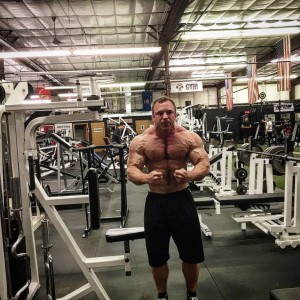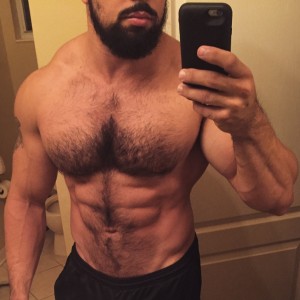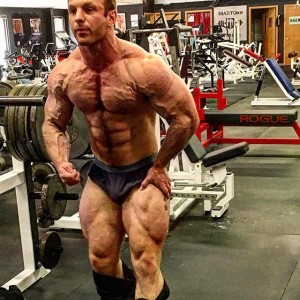
21 Mar 10/20/Life for Powerbuilding: An Introduction
By: Tucker Loken & Danny Vega
If you have been following my logs recently, you would know that I have switched gears and have been experimenting with a more bodybuilding-friendly style of training and diet. Brian and I spoke sometime late last year about all of the projects he wanted to complete and one of them was a 10/20/Life for Powerbuilding E-book. Since looking jacked has always been a goal of mine, regardless of what sport I played, I really loved that idea and knew I wanted to be involved.
[wa-wps]We are currently brainstorming together and have come up with some great ideas, thanks to my new favorite bodybuilding guru, Tucker Loken. If you don’t know Tucker’s background, Check this out.
Tucker has been extremely helpful and he knows his stuff! It only makes sense to include someone with a bodybuilding background, and I can tell you that as a strength athlete, I’m new to a lot of his concepts. But I can clearly see the benefits they have for a powerlifter. So we decided to introduce our take on powerbuilding, and how it could help Powerlifters.
D: What is Powerbuilding in your opinion and who would benefit from doing this type of training?
T: Webster’s defines Powerbuilding as the unique ability to have a balanced, jacked, cut, and yoked physique and be strong as a mofo all at the same time.
Okay – what is powerbuilding for real? Powerbuilding is when you want to build more than a physique that is pleasing to the eye, you want to build a physique that is functional and can move real weight. Nobody wants to be able to put 4 plates on each side of a chest press machine for reps, only to be crushed by 3 plates on a regular bench press. A powerbuilder focuses on proficiency in the big 3 lifts (Squat, Bench Press, Deadlift) because they are the best determinants of raw strength with a barbell. Powerbuilding also focuses on creating a bodybuilding type physique with all the qualities of broad shoulders, trim waist, low body fat and balanced muscle mass to create an aesthetically pleasing (and freaky) physique.
Any powerlifter could benefit from a powerbuilding type of scheme as long as it is programmed to best fit their personal lifting style and weak points.
D: What could a powerlifter gain from training this way and when/how often would he or she incorporate type of training?
T: Bodybuilding and powerlifting have great crossover potential to help the competitor improve. Along with the necessary accessory work that should be given to someone to improve their squat, bench press and dead lift, the functional help some extra bodybuilding style hypertrophy work can help with would be to even out weak points, prevent injury, and increase neural connectivity and mind muscle connection to a certain body part. I personally believe that if a powerlifter does their smaller exercises with the mind muscle connection as a priority, rather than just moving the weight around, they greatly increase their potential for strength. No one is going to have too good of body awareness, and the ability to engage more muscles to aid in moving big weights is only going to help them reach their goal.
To put it in a real life scenario, when focusing on a bench press, or a key assistance exercise like a 3 board press for overload work, an athlete doesn’t need to be prioritizing feeling their pecs, they just need to find the most efficient way to move weight through space. However, if they are weak off their chest and need to build stronger pecs, the problem might be that they have poor muscle connectivity and the pecs don’t ever get activated enough to build evenly with the rest of the pressing system. Focusing on feeling the pecs in their smaller assistance work like dumbbell presses, machine work, pec flys, dips and other movements is going to develop their pec muscles and increase the nervous system’s connectivity with them. When the pecs can fire more effectively on these smaller exercises, they will also engage better in the bigger compound pressing movements, thus helping the athlete move more weight more efficiently.
D: Why do you think most powerlifters hesitate to start a program like this, and why do you think they should start it in the first place?
T: Because anyone who loves what they do and takes it seriously gets very myopic in their goals. You count and covet your PR’s and meet totals and want to keep pushing and getting better all the time. You want to just keep pushing at that singular goal, and think anything that isn’t 100% directed towards that won’t possibly help. What happens when you hit a plateau though and after a couple training cycles you still haven’t made much progress? Training isn’t linear, and sometimes for the benefit of your body and mind it’s helpful to take a step back and look at what else you can do. With the powerbuilding scheme you’re trying now, the reps on the compound movements are a little bit higher than in the normal 10/20/Life protocol, more in the 4-8 range than the 1-5 range. Is this optimal year round for maximal strength output? No, but for a 10 week off season period when you need to give your body a break from straining with the same old weights you have been it might be just what you need.
Think of it this way – if the most you ever do on the big 3 are sets of 5, then your rep strength for a set of 8 isn’t going to be very good. When you start using those rep ranges you’ll feel like you’re making newbie gains again, and your strength for those high rep sets will be going up regularly and you’ll see progress. That can be really mentally motivating, but also has great physical attributes. If you get stronger at a set of 8, you’ll definitely get stronger for a set of 3, it may take you a little bit to get back into the swing of the heavier weights again, but stronger is stronger, and the time working on something else will have some great direct and indirect benefit to your goals.
D: Where do most powerlifters go wrong when incorporating this type of training?
T: The biggest flaw I see is that powerlifters either go too heavy or too light on their assistance work. They do their deadlifts and deficit deadlifts spot on, but just sling the weight on their barbell or dumbbell rows. They are “powerlifters” after all, so they should be able to move some heavy stuff, so they grab the heavy dumbbells and throw them around without really focusing on what muscle they are working. Are they really focusing on getting their lats, rhomboids and traps to fire, or are they just moving weight through space? Maybe they decided to throw in some curls at the end of a back and bi’s day, and now they just do some high rep stuff to “flush blood” for healthy elbows and injury prevention. They take it a little bit easy and just curl the weight up and down without really squeezing the muscle and pumping maximal amounts blood into the area – particularly the brachialis and other forearm muscles which really need it to stay healthy.
It all comes down to intent and focus. A big deadlift may be the goal, but training programs aren’t structured haphazardly (particularly the 10/20/Life programs), and everything has a purpose. Focusing on the muscles of the mid back on the dumbbell rows assistance work will help to strengthen the lats, traps and stabilizer muscles of the shoulder blade like the rhomboids and serratus. Getting those muscles in particular to develop and fire correctly and together will help all 3 of the big lifts. I think a lot of lifters would be surprised how many muscles they missed during the movement once they slow down and focus a little bit more on the muscles they are working.
D: I would also add that another way powerlifters go wrong is that they want immediate results. Let’s be honest here—a lot of y’all are head cases (myself included)! Either you wake up one morning and realize that you are a huge tub of lard and crash diet for a few months, or you bulk up with reckless abandon. The former will lead to a weaker, skinny-fat you, the latter will lead to you putting on too much fat for no reason. What we are proposing is that you approach this the same way you would an off season or meet prep—it is going to take time and minimal adjustments to preserve/build muscle and get leaner without losing strength, and you have to set realistic goals.
D: Why does the 10/20/Life philosophy work with powerbuilding?
T: The 10/20/Life philosophy works well with powerbuilding because it sets the athlete up for long term and consistent gains based on thoughtful programming and conservative use of top lift testing. This amount of freedom leaves room for the power builder following the program to put some time into hypertrophy work, especially during the lighter RPE period of the off season. The lifter will be recovering well and this is a good time to put some bodybuilding exercises into your routine. Some extra shoulder raises and machine presses will go a long way to developing stronger shoulders and pecs for pressing, and some high rep leg presses and leg extensions will help bring up your quads if you’re having trouble finishing a squat. The frequent de loads will ensure that whoever is following the program will recover fully.
Personally, I love walking out of the gym with a pump. It feels awesome. I’ve done the squat, bench, dead each day you get into the gym routine with very little assistance work – it served its purpose well by giving me a lot of frequency to practice the lifts over and over each week, but A) I found the amount of volume on the exercises to be too much for my body to handle, and B) I didn’t ever feel jacked or pumped. I just felt like I got done with a day of manual labor – picking things up and putting them down. 10/20/Life is structured well to make for an easy crossover for someone used to a bodybuilding type of routine. The bodybuilder who wants to get strong, or the powerlifter who wants to build a physique will have enough freedom to make what they want out of the routine.
D: I agree. In conclusion, I will say that a lot of us get tunnel vision when it comes to our total and training becomes a chore. Some of us can deal with that stress longer than others. There is nothing wrong with taking a step back and setting some other goals for yourself. You may give your mind and body the break that it needs and in the long run, become a better, more jacked and beautiful™ Powerlifter.
Get The 10/20/Life Ebook HERE!
Danny Vega
Latest posts by Danny Vega (see all)
- Danny Vega – High Protein recap and training - November 8, 2017
- Danny Vega – Hypertrophy Experiment UPDATE - October 28, 2017
- Danny Vega – Hypertrophy Week 1 – 1020Life Seminar - October 9, 2017








Sorry, the comment form is closed at this time.